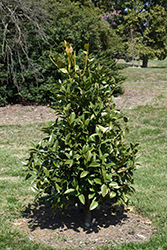It's all about ...
plants

Leah Bates Lusterleaf Holly
Ilex latifolia 'Leah Bates'
Height: 10 feet
Spread: 6 feet
Sunlight:
![]()
![]()
Hardiness Zone: 7a
Description:
This compact selection features lustrous, dark green, foliage with spiny edges; bright red fruit in clusters along the stem, adds color to the fall and winter landscape; best in evenly moist, acidic soil; attractive pyramidal growth habit for small spaces
Ornamental Features
Leah Bates Lusterleaf Holly is primarily grown for its highly ornamental fruit. It features an abundance of magnificent red berries from early fall to mid winter. It has attractive dark green foliage with grayish green undersides which emerges chartreuse in spring. The spiny pointy leaves are highly ornamental and remain dark green throughout the winter.
Landscape Attributes
Leah Bates Lusterleaf Holly is a dense multi-stemmed evergreen shrub with a distinctive and refined pyramidal form. Its average texture blends into the landscape, but can be balanced by one or two finer or coarser trees or shrubs for an effective composition.
This shrub will require occasional maintenance and upkeep, and is best pruned in late winter once the threat of extreme cold has passed. It is a good choice for attracting birds and bees to your yard. It has no significant negative characteristics.
Leah Bates Lusterleaf Holly is recommended for the following landscape applications;
- Mass Planting
- Hedges/Screening
- General Garden Use
- Naturalizing And Woodland Gardens
Planting & Growing
Leah Bates Lusterleaf Holly will grow to be about 10 feet tall at maturity, with a spread of 6 feet. It has a low canopy with a typical clearance of 1 foot from the ground, and is suitable for planting under power lines. It grows at a slow rate, and under ideal conditions can be expected to live for 50 years or more. This is a female variety of the species which requires a male selection of the same species growing nearby in order to set fruit.
This shrub does best in full sun to partial shade. It requires an evenly moist well-drained soil for optimal growth. This plant does not require much in the way of fertilizing once established. It is particular about its soil conditions, with a strong preference for rich, acidic soils. It is somewhat tolerant of urban pollution, and will benefit from being planted in a relatively sheltered location. Consider applying a thick mulch around the root zone in winter to protect it in exposed locations or colder microclimates. This is a selected variety of a species not originally from North America.
This plant is not reliably hardy in our region, and certain restrictions may apply; contact the store for more information.
